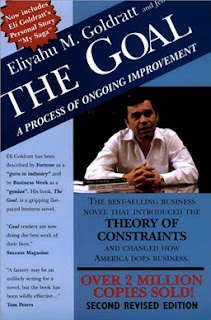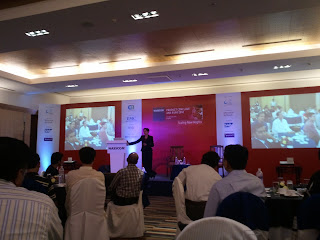Last month I was in Justbooks around the time they were closing so just picked 2 books as directed by my subconscious. Once I started reading I realised that I heard about this book first in the 2007 Ooty Thoughtworks Awayday. Apparently the subconscious mind remembered about this book when I was going to randomly pick 2 books – amazing how neurons work
Goal was written by Dr.Eliyahu M.Goldratt as a marketing ploy to sell their software which did some scheduling. No one knows about the software – but the book became a roaring success – after rejects by 20 publishers.
The book brings out some interesting concepts – even though it revolves around a manufacturing plant – it soon becomes apparent that the concepts can be applied against any industry or business.
What is the Goal?
Alex is the head of a production plant. Orders are always delayed and is a loss making plant. His boss gives him 3 months to turn it around or close the plant. Alex meets his high school physics teacher who mentors him into finding the right path – and the first question he asks is – what is the Goal of your production plant.
Is it quality, productivity – no – the goal is to make money now and in the future. This very realization sets a whole chain of interesting concepts.
Herbie the fat kid
This is a must read part of the book – they bring out the concept of bottleneck in a brilliant manner. Some 20 boy scouts go on a 8 mile trek led by Alex. As per common sense the fastest kid is put on the front of the trial – so he will set a fast pace and they can cover the distance quickly.
They stop for lunch ( mid day ) and realize that they have not covered even 2 miles of the 8 miles. At this pace it will be quite dark by the time they reach the destination.
Soon Alex finds out that Herbie – the fat kid – is in the middle of the trial and he is slowing people down behind him. So he moves him to the end of the trial. Even this does not work and the pace does not improve.
Then he moves Herbie to the front of the line and also take some load off his back – so Herbie can walk a bit faster. Wonder of wonders – the pace improves drastically and they reach the destination on time.
The reasoning is brilliant – you go read the book – I wont spoil it for you 🙂
In any system – identifying Herbie – or the bottle neck is of utmost importance. Once identified you can either move it to the front of the chain ( will not be possible in most of the cases ), or add more resources and optimize the bottle neck.
There are lots of advantages of the bottle neck :
1. Bottleneck determines the throughput of the system
2. This helps in scheduling things around it – so the quantity and delivery time can be predicted accurately.
3. The inventory can be planned more smartly with this information – hence reducing the warehouse costs
Herbies are the weakest link, or the slowest part of the system. They determine the strength of the whole chain.
And the bottleneck will keep moving as the Herbie gets identified and gets optimized. Other Herbies will start springing up – and have to be dealt with.
Theory of Constraints
This brings us to a brilliant deduction :
The Rate of achieving a goal is limited by atleast one constraining process.Only by increasing flow through this constraint the overall throughput can be increased.
Simple, common sense – but we totally miss this.
5 Focussing Steps
- Identify the constraint (the resource or policy that prevents the organization from obtaining more of the goal)
- Decide how to exploit the constraint (get the most capacity out of the constrained process)
- Subordinate all other processes to above decision (align the whole system or organization to support the decision made above)
- Elevate the constraint (make other major changes needed to break the constraint.
- If, as a result of these steps, the constraint has moved, return to Step 1. Don’t let inertia become the constraint.
That is all there is – and this philosophy can be applied to any system.



